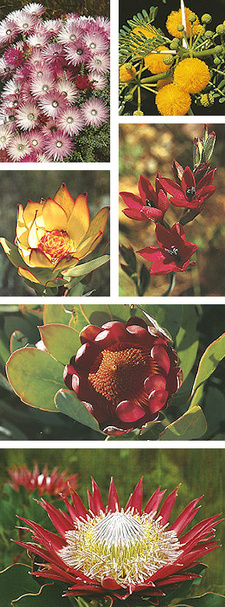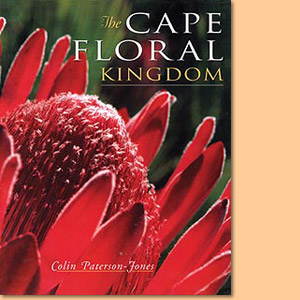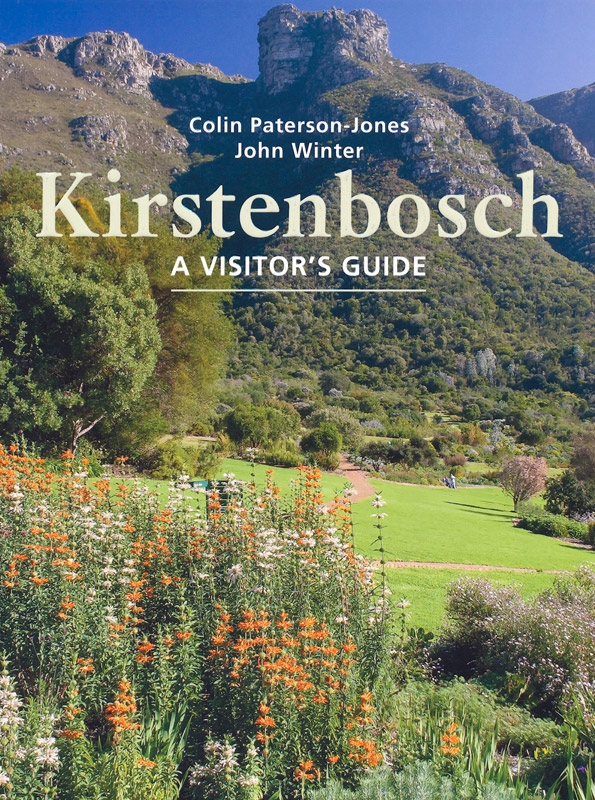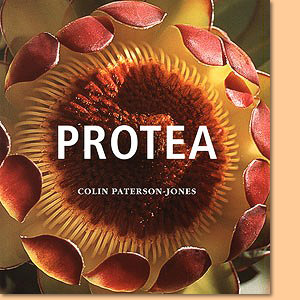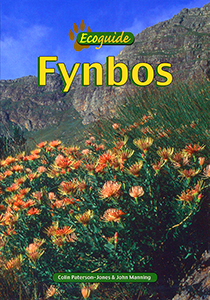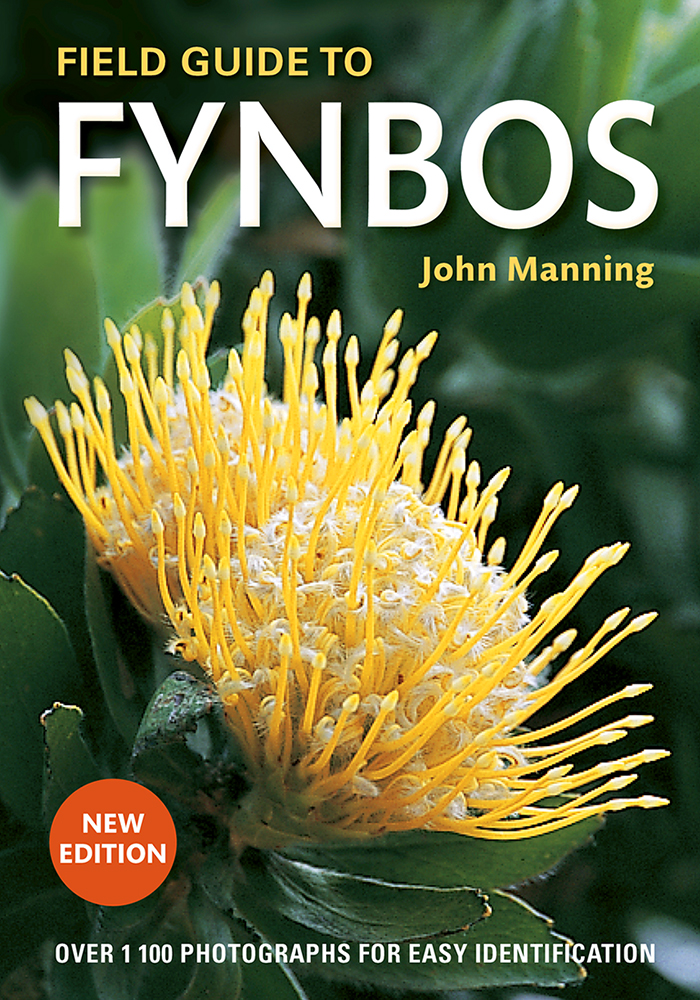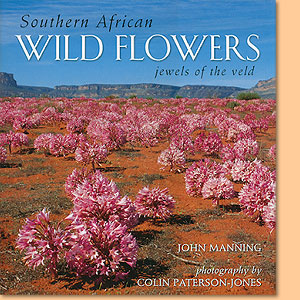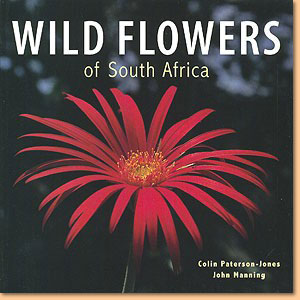The Cape Floral Kingdom, by Colin Paterson-Jones
Introduction by Colin Paterson-Jones: The Cape Floral Kingdom is one of the world's most precious natural assets. So special is the floral wealth on the southern tip of Africa that, as part of the World Wide Fund for Nature's WWF 2000 global conservation campaign, it was identified in 1996 as one of the top twenty among 200 key eco-regions worldwide that are crucial in the drive to conserve nature into the next millennium.
Africa is the cradle of mankind. Fossil records show that Early Stone Age man lived on the southern extremity of the continent for at least 500000 years. Later came the Bushman (San) hunter-gatherers, who roamed the region from about 21000 years ago, but sadly we shall never know whether and to what extent they valued its flowers for their beauty: plants are not depicted in their rock art here, and it seems that they did not play a large part in the mystically religious experience, the main subject of the Bushmen's paintings. We do know though, that their more recent relatives, the Khoikhoi pastoralists who brought their flocks of sheep (and, later, herds of cattle) to the south-western and southern Cape about 2000 years ago, made extensive use of the region's plants for food and medicine.
What has been well recorded is the excitement aroused by the first plants collected and sent to Europe more than 150 years, from the time Bartholomeu Dias rounded the Cape in 1488, ships plying the newly charted trade route to the East put ashore on the Cape coast to replenish their water and fresh food supplies. On some of these brief stopovers sailors would collect what to them were strange plants, which they carried back to their home countries. The European Renaissance that spanned the 16th and 17th centuries was a time of discovery, the beginning of the age of scientific enquiry. Rich merchants, members of the nobility and universities created and maintained gardens filled with plants from all over the then known world. Herbalists who studied these living collections and dried material produced books known as 'herbals', in which they described the different species and made the first attempts to understand how they were related.
Examples from distant parts of the world were especially prized. The first depiction of a Cape flower - a dry flower-head of Protect neriifolia - was in Clusius' Exoticorum libri decem, which was published in 1605 in Leiden. Many of the Cape plants featured in the herbals of this time consisted of bulbous species, one of the first of which has been identified as the April fool flower (Haemanthus coccineus). The collecting of Cape plants, even at this early time, was an organized rather than a haphazard process. The wealthy European patrons of the trading expeditions that sailed around the Cape commissioned their ships' captains to gather exotic species, which would later be incorporated into the gardens that were becoming increasingly fashionable and major objects of interest. The establishment of the Dutch East India Company's settlement at the Cape of Good Hope in 1652 provided the stimulus for even more serious and extensive collecting. So began a tradition of botanical exploration at the Cape which has continued uninterrupted until today.
The most celebrated of the early botanists to come to the Cape was Carl Thunberg, then 29 years old, was the brilliant student of Carl Linnaeus, the famed Swedish natural scientist who worked at the University of Uppsala. Linnaeus brought order to the rapidly increasing body of knowledge about living organisms and their relationships by introducing the systematic method of naming them that is still used today. According to his binomial system, each species is given a two-part name — for example. Protect neriifolia. The second element (neriifolia) identifies the species, the first (Protea) the name of the genus to which the species belongs. While neither the genus nor the species name is necessarily individually unique, the combination always is.
To elaborate: populations of plants which share the same overall characteristics, and which interbreed, form a species. Different species which share one or more specialized characteristics are grouped into a genus. All the species (and, therefore, genera) which share the same basic floral form and structure, or some other uniquely important characteristic, are gathered into one plant family and collecting plants, making several expeditions into the interior and along the south coast. He left for Japan in March 1775 to spend further four years in botanical exploration. Soon after his return to Sweden he took up the chair of botany at Uppsala University, replacing Linnaeus' son (who briefly succeeded his renowned father). One of the legacies of Thunbergs time at the Cape is his Flora Capensis, the first systematic account of the region's plant life. Succeeding generations of botanists added to this monumental work as they searched for, located and recorded ever more of the Cape's abundant plant species.
Today, even after centuries of intensive exploration, the Cape still yields hitherto unknown plants. Noteworthy among recent discoveries has been Mimetes chrysanthus, located in the Gamkaberg species Nature Reserve in 1987. An undescribed species of Cyrtanthus, which came to light near the pleasant southern Cape town of Swellendam, was only one of several new discoveries made in 1997. With the accumulation of knowledge came the realization that the Cape Flora is essentially unlike any other elsewhere. So different and varied are the species that grow naturally here that the region has been named the Cape Floral Kingdom, one of only six floristic kingdoms into which the world is divided and enjoying the same status as, for example, the great Boreal Kingdom which covers most of the northern land masses of Europe, Asia and North America - an area of 50 million square kilometres, or 500 times that of over 950 plant genera found here, and a staggering 68 per cent of the more than 8500 species, are endemic. Also unique are the five endemic families (Stilbaceae, Penaeacear, Geissolomataceae, Roridulaceae and Grubbiaceae), and three near endemic families (Bruniaceae, Lanariaceae, Prioniaceae. The Proteaceae (restricted to the southern hemisphere (restricted to Africa), and the Restionaceae(essentially Cape) are among the Cape Flora's ten largest families.
The Cape Flora also boasts a remarkable number of geophytes (that is, plants with bulbs, tubers or corms): the iris family (Iridaceae), for instance, is another of the region's ten most extensive families. In broad terms, the Cape Floral Kingdom encompasses the mountain ranges that run roughly parallel with the western and southern Cape coasts and the land between them and the sea. It is bordered in the north-west by Namaqualand, inland by the Great Karoo, and in the east by the eastern Cape. Within this region, the plant life varies greatly. The major vegetation type is fynbos, which covers over 80 per cent of the area. Fynbos is characterized by the dominance of hard-leaved plants and the presence of Cape reeds — species of the Restionaceae - which here take the place of grasses elsewhere as the main understorey component. Also characteristic are shrubs of the protea and erica families (Proteaceae and Ericaceae), although these are not always present.
Fynbos comes in many forms, and one of the reasons for the huge number of species in the Cape Flora is the way this vegetation varies in different habitats. It is the dominant vegetation on both the mountains and the coastal plains, where it generally grows on such nutrient-poor soils as the leached-out white sands that occur here. One specialized type of fynbos grows on the coastal limestone hills, another is found on coastal dunes. Where rainfall is sufficiently high, fynbos will grow on the clay soils of the lower mountain slopes, but these and the flats below them, which have the same shale-derived ground, generally carry a natural vegetation type known as renosterveld. The name comes from the renosterbos (Elytropappus rhinocerotis), a shrub with fine, grey leaves and so common that it gives the renosterveld countryside its characteristic, generally drab appearance. First impressions, though, are misleading: renosterveld contains large numbers of uniquely beautiful bulbous plants which are among the glories of the Cape Flora when they flower. Most of them bloom in spring.
The plant species found in fynbos and renosterveld make up most of the Cape Flora but there are other minor vegetation types represented. Temperate forests cover large areas of the southern coastal regions, and there are small patches of forest in wet sites on mountain slopes as far west as Cape Town's Table Mountain. In sharp contrast with the fynbos, though, the forests are poor in species. In the dry valleys between the east-west lying mountain ranges you will find succulent Karoo vegetation, a type characterised by small succulent plants and which is dominant in the Namaqualand coastal belt to the north. A thicket type of vegetation called strandveld occurs here and there on limestone soils around the coast. Valley bushveld, a subtropical thicket vegetation, is characteristic of the Eastern Cape, entering the Cape Floral Kingdom at its eastern limits.
The Cape Floral Kingdom is divided into six regions:
The North West region encompasses the Bokkeveld Escarpment and the Matsikamma which tower grandly above the southern part of Namaqualand's Knersvlakte); the Cedarberg, the Kouebokkeveld, Tulbagh, Ceres and Worcester mountains; Piketberg; and the coastal plain between the Berg and Olifants river mouths.
The South West region covers the whole of the coastal plain south of Piketberg; the Cape Peninsula; the contiguous Bainskloof, Du Toit's Kloof, Franschhoek, Stellenbosch, Villiersdorp and Hottentots Holland mountain ranges; the Worcester-Robertson Karoo; the Riviersonderend range; the Kleinrivier range between Hermanns and Bredasdorp; and Potberg, an isolated mountain on the Agulhas Plain.
The Agulhas Plain stretches from Gansbaai in the west to Mossel Bay in the east, and includes Cape Agulhas, the southernmost tip of Africa.
The South Inland Mountain region contains the Witteberg and Swartberg ranges; the broken range of the Touwsberg, Gamkaberg, Rooiberg and the Kammanassies; and the Little Karoo, the distinctive region that lies between the coastal rampart and the Swartberg to the north.
The Langeberg range of mountains and its forelands comprise the fifth region.
The South East region, which probably has the most varied vegetation of all, includes the southern Cape coast and the unbroken Outeniqua/Tsitsikamma range which lies behind; the Langkloof, Baviaanskloof and the surrounding mountains; and the Groot Winterhoek mountains.
This book illustrates just some of the host of beautiful, rare or interesting plants in the Cape Flora. The choice of species depicted is to some extent personal, has no taxonomic significance and is not representative - many families of the Cape Flora are not featured here. The illustrations are arranged according to the six regions, starting in the north-west, travelling south to the Cape Peninsula, and then eastwards. The flowers from the mountains, the forelands and the coast (if applicable) are grouped within each region. Only some of the species shown are endemic to a particular region, but the forms of more widespread species belong in the sections in which they are illustrated.
Content of The Cape Floral Kingdom
INTRODUCTION
THE NORTH WEST
Bokkeveld Escarpment
Matsikamma and the Cedarberg
Ko uebokkeveld
Piketberg, Ceres and Tulbagh Mountains
Worcester Mountains
Forelands
THE SOUTH WEST
West Coast
Western Forelands
Cape Peninsula.
Du Toit's Kloof, Bainskloof, Franschhoek
and Stellenbosch Mountains
Hottentots Holland Mountains
Southern Forelands
Coastal Mountains
Riviersonderend Mountains
THE AGULHAS PLAIN
THE LANGEBERG RANGE
THE SOUTH INLAND MOUNTAINS
Touwsberg, Gamkaberg, Rooibergand
the Kammanassies Mountains
Little Karoo
Swartberg Range
THE SOUTH EAST
South Coast
Forest
Outeniqua and Tsitsikamma Mountains
Baviaanskloof and the Groot Winterhoek
Mountains
THE CAPE FLORA
Origins
Interactions
Finding the Flowers
INDEX OF SPECIES
ACKNOWLEDGEMENTS
This is an extract from the book: The Cape Floral Kingdom, by Colin Paterson-Jones.
Book title: The Cape Floral Kingdom
Author: Colin Paterson-Jones
Struik Publishers
Cape Town, South Africa 2003
ISBN 1868728927
Hardcover, dust jacket, 22x26 cm, 144 pages, throughout colour photos
Paterson-Jones, Colin im Namibiana-Buchangebot
The Cape Floral Kingdom
The Cape Floral Kingdom features the rich and unique world of wild flowers of South Africa.
Kirstenbosch: A visitor's guide
A colourful and highly informative visitor's guide to South Africa's extraordinary park, Kirstenbosch.
Ecoguide Fynbos
This ecoguide introduces 400 wildflowers and birds, insects, spiders, reptiles and mammals in their environment in the Fynbos region of South Africa.
Field Guide to Fynbos
Field Guide to Fynbos features 1150 species of Fynbos, focusing on the most common and conspicuous wild flowers of South Africa.
Southern African Wild Flowers: Jewels of the Veld
Celebrates the beauty of Southern African wild flowers that truely are to be said the jewels of the veld along the landscapes.
Wild Flowers of South Africa
Offers a glimpse into South Africa’s rich floral heritage, enabling the reader to enjoy our most spectacular flowers

